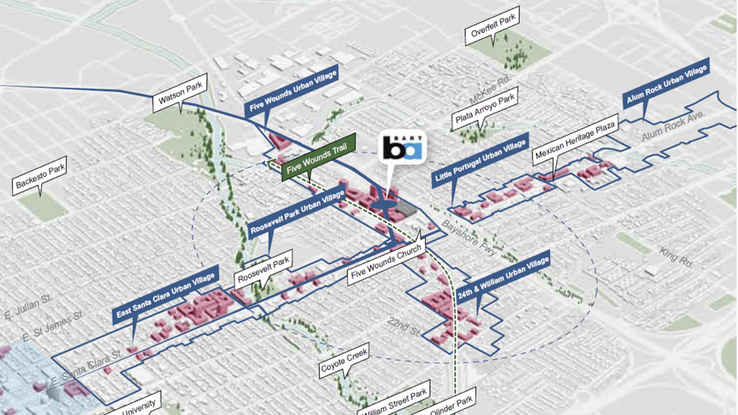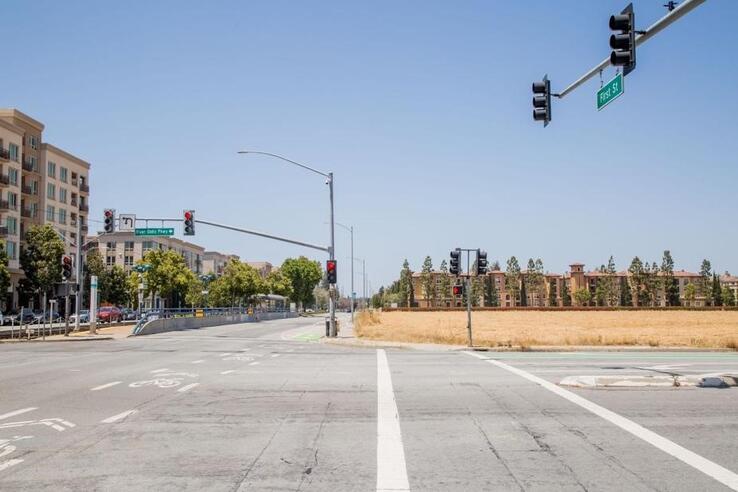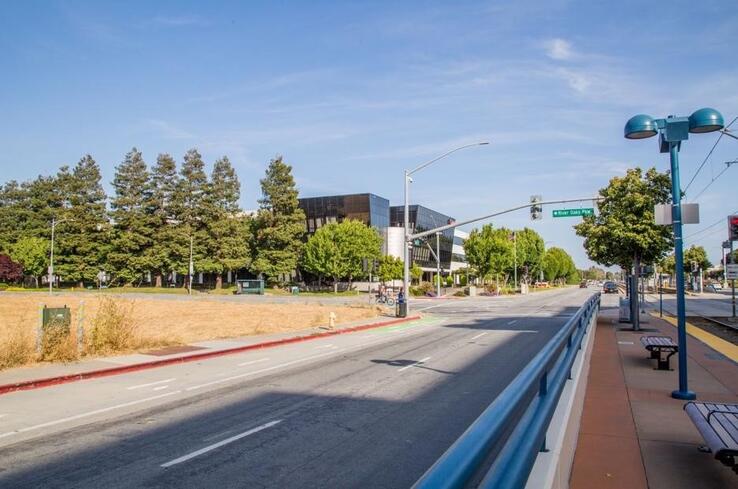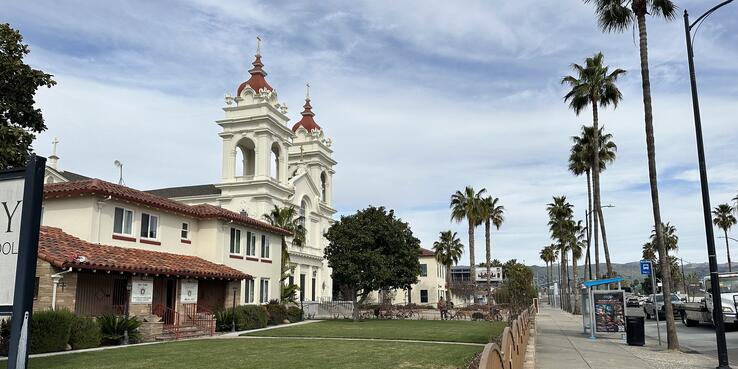In
The TOC Policy’s goals broadly reflect goals of the City of San José and
SPUR examined what the TOC Policy would mean for two station areas in San José: 28th Street Little Portugal, where a future BART station is proposed, and the North First Street light-rail corridor. We convened key community stakeholders and city staff to hear how they think the policy either helps or creates challenges for ongoing planning and community objectives for the two stations. We explored the implications of the TOC Policy for San José’s
28th Street Little Portugal
The proposed 28th Street Little Portugal Station will be part of the BART extension to downtown San José. The long-planned station will serve a diverse and vibrant San José neighborhood with a long history of community engagement and advocacy that has guided planning and economic development. The station was to be completed by 2030, but the current schedule is being refined. Financial and ridership changes resulting from the COVID-19 pandemic have meaningfully altered the context.
How does the TOC Policy affect the broader station area?
The San José Housing Element identifies three preliminary opportunity sites within one-half mile of the proposed 28th Street Little Portugal Station, which is subject to the TOC Policy. Existing policies for these housing opportunity sites largely comply with the TOC Policy when it comes to maximum allowable densities, affordable housing preservation, and tenant protections. They don’t comply with the TOC Policy with respect to minimum density requirements for housing and offices.
Another requirement of the TOC Policy is that municipal plans identify
Differences Between Current Standards and TOC Standards at Preliminary Opportunity Sites Near the 28th Street Little Portugal Station
Current zoning at the three station-adjacent opportunity sites often does not meet the TOC Policy’s minimum allowable densities for housing and offices. If San Jose updates its zoning to comply with the policy, future development will have to deliver more housing or jobs at the three sites.
| Site Address (Zoning)* | Current Standards | TOC Standards | ||||||
| Housing Density (units/acre) | Office Density (floor area ratio) | Housing Density (units/acre) | Office Density (floor area ratio) | |||||
| Max | Min | Max | Min | Max | Min | Max | Min | |
| 1075 E Santa Clara St (Urban Village) | No Max | No Min | No Max | .50 | 100 | 75 | 6 | 3 |
| 224 N 27th St (Urban Village) | 250 | No Min | No Max | .75 | ||||
| 1001 E Santa Clara St (Urban Village) | No Max | No Min | No Max | .50 | ||||
Sources: San José Zoning and Metropolitan Transportation Commission’s Transit-Oriented Communities Policy
* Applicable city density standards can vary according to whether the proposed development is fully commercial or mixed use.
How can local stakeholders use the TOC Policy as a tool to achieve their goals?
Stakeholders identified three ways to leverage the TOC Policy to support their station area objectives. First, the policy provides a toolbox of policies that stakeholders can use to press for preserving affordable housing and protecting existing tenants and businesses. Second, the required station access gap analysis gives stakeholders a tool to demand more serious attention to pedestrian safety needs within the broader station area. Advocates voiced serious concern about the safety of pedestrians and cyclists who will be accessing the future station from the east side of adjacent Highway 101. The TOC Policy requires attention to the full 15-minute pedestrian radius, bringing a welcome focus to the challenging freeway barrier. Finally, the TOC Policy’s parking maximums requirement could help counter constant pressure to increase the amount of new parking — pressure antithetical to the goal of attracting more transit-reliant businesses and housing.

The City of San Jose has approved six urban villages within one-fifth of a mile of the 28th Street Little Portugal BART station.
Image courtesy City of San José
North First Street Corridor
The North First Street corridor along the blue and green lines of VTA’s light rail system links downtown San José to North San José and extends to the cities of Santa Clara and Mountain View. SPUR’s analysis considers implications of the TOC Policy for stations between Gish and River Oaks — a stretch of car-oriented park-and-ride stations with enormous potential for transformational development due to many existing surface parking lots, as well as vacant and underdeveloped commercial parcels. The city expects to site more than 24,000 housing units in North San José, as described in its current Housing Element. This figure represents 39% of all the housing that San José must build according to the state Regional Housing Needs Allocation process.


Opportunity sites along the North First Street light rail corridor would promote land uses that maximize housing and jobs and minimize auto-oriented uses.
Photos by
How does the TOC Policy affect the broader station area?
San José’s Housing Element has identified a number of preliminary opportunity sites along the North First Street corridor. Although North José has been a growth area for the city, it includes only one approved urban village plan and has no VTA TOC playbooks to guide development. North San José has long been envisioned as an employment hub served by light-rail transit, and previous city plans have concentrated employment growth in this area. As a result, housing is currently not zoned for many of the North San José opportunity sites included in the current
Regarding station access requirements, San José is just beginning a new multi-modal transportation plan for the North First Street Corridor. The plan represents an opportunity for the city to consider the TOC Policy’s required station access gap analysis. It also represents an opportunity for the city to consider how to meet the TOC Policy’s parking requirements.
Differences Between Current Standards and TOC Standards at a Selection of Preliminary Opportunity Sites Near the North First Street Corridor
One opportunity site, 155 River Oaks, fully complies with TOC Policy density requirements. Other sites do not meet minimum zoning requirements.
| Site Address (Zoning)* | Current Zoning | TOC Standards | ||||||
| Housing Density (units/acre) | Office Density (floor area ratio) | Housing Density (units/acre) | Office Density (floor area ratio) | |||||
| Max | Min | Max | Min | Max | Min | Max | Min | |
| 155 River Oaks Pkwy (Transit Residential) | 250 | 50 | 12 | 2 | 75 | 50 | 4 | 2 |
| 1490 N 1st St (Urban Village) | 250 | 0 | 10 | No Min | ||||
| 3331 N 1st St (Transit Employment Overlay) | 250 | 75 | 12 | No Min | ||||
| 3011 N 1st St (Transit Employment Center) | housing not allowed with transit employment center designation | 12 | No Min | |||||
Sources: San José Zoning and Metropolitan Transportation Commission’s Transit-Oriented Communities Policy
* Applicable city density standards can vary according to whether the proposed development is fully commercial or mixed use.
How can local stakeholders use the TOC Policy as a tool to achieve their goals?
Current density minimum and maximum targets along the North First Street corridor will not meet TOC Policy requirements in many cases. Stakeholders suggested that they can use the policy to ensure that mixed-use residential and commercial hub development along the corridor creates new affordable housing for all income levels. They think the TOC Policy will help deliver ambitious housing goals for the corridor in San Jose’s Housing Element. They strongly support additional incentives to deliver housing closer to light-rail transit stations.
Bicycle advocates said the TOC Policy’s parking constraints and station access requirements would be helpful tools to reduce the corridor’s auto orientation.
Representatives of neighborhood organizations are more skeptical of the TOC Policy’s parking constraints and density requirements. They suggested that the corridor lacks the level of transit and commercial services necessary to reduce car ownership and use. They are happy that the policy does not apply to existing residential land, so it will not directly influence density and parking standards in adjacent residential areas.
TOC Policy Implementation Challenges for San José
The TOC Policy presents unique challenges for San José. With 54 stations subject to the policy, the city faces a daunting task to deliver the zoning changes, station access planning, and equity policies demanded by the TOC Policy. Moreover, city staff members have serious concerns about the TOC Policy's proposed parking maximums, a proposal the city considered but dismissed during recent parking policy reforms due to stakeholder feedback and concerns about negative market implications. After years of study, the city has recently made bold changes to its parking policies, including elimination of minimum parking requirements and the ability for developers to select from a menu of actions that reduce single-occupant vehicle travel. City staffers believe that a new layer of parking constraints would disrupt the recent political compromise.
Broadly, San José has been slow to consider the implications of the TOC Policy for ongoing planning efforts. The 2026 deadline for policy compliance left staff with the impression that there was no need for immediate action. However, the TOC Policy has implications for near-term decisions. For example, San José recently approved single-family homes within the Berryessa BART station area — homes that are below the minimum density levels allowable by the TOC Policy. This action does not contradict the TOC Policy directly because the policy’s density requirements are based on averages for the entire station area. What it does is subject surrounding areas to even higher densities in order to achieve an acceptable average density. Consideration of the TOC Policy’s density requirements was never part of the approval conversation, suggesting that stronger communication from MTC is required to inform jurisdictions about the TOC Policy’s near-term implications.
Another disconnect between the TOC Policy and San José’s planning involves MTC funding for the BART to San José extension, and MTC’s support for future state and federal funding for this project. MTC’s support for this extension depends on a formal commitment from the city to comply with the TOC Policy. But the city has only begun to consider what might be required for such a commitment because it hasn’t understood that near-term funding decisions could be at risk.
Finally, application of the TOC Policy in San José raise
Waiting for Certainty
For the 28th Street Little Portugal Station Area and the North First Street Corridor, the TOC Policy is a valuable tool for local stakeholders advocating for safer and more affordable station access options, anti-displacement policies, and less automobile-oriented development. However, in multiple meetings that have taken place in the 10 months since the TOC Policy was approved, the policy’s standards have been rarely referenced during station area planning processes. The City of San José is unclear about whether MTC is serious about the funding conditions attached to the TOC Policy. Because San José is uncertain about MTC’s timing and flexibility with regard to the TOC Policy, it has waited to grapple with how the policy impacts its station area planning. This conundrum argues for stronger and clearer communication from MTC about TOC Policy requirements and for reinforcement of MTC’s plans to condition future funding on compliance with the policy.
SPUR is grateful to The San Francisco Foundation
